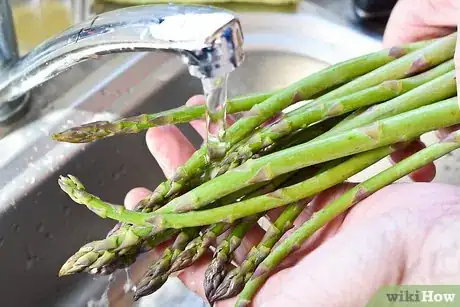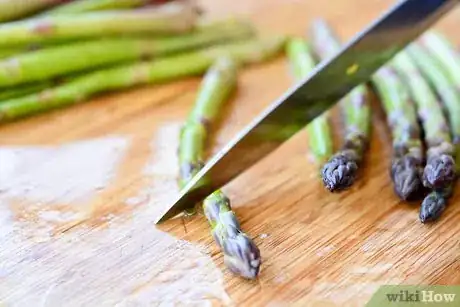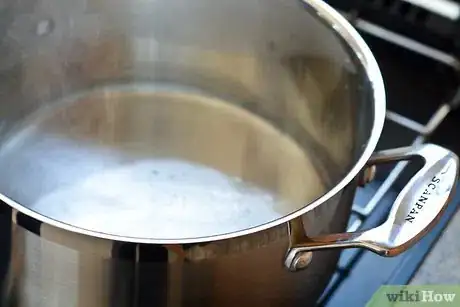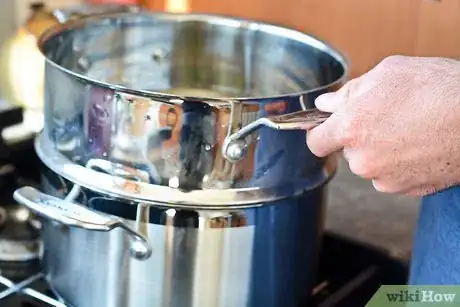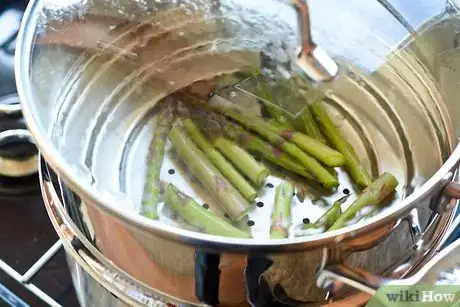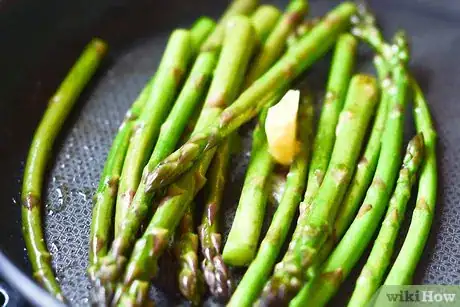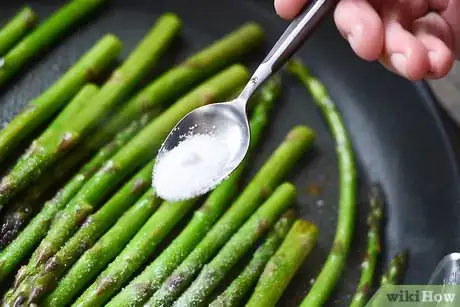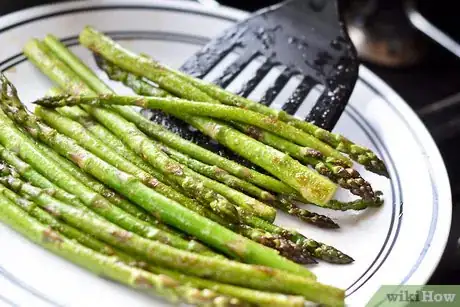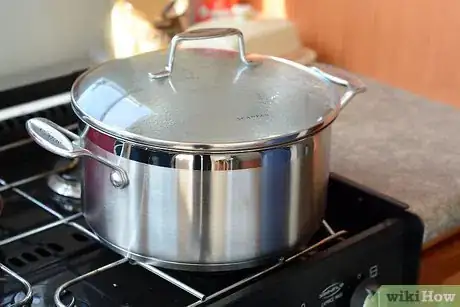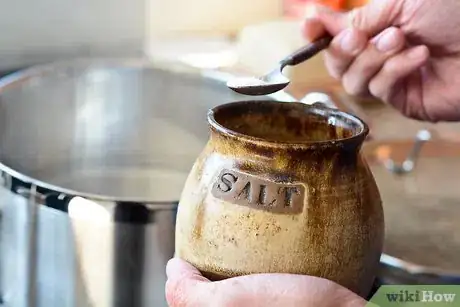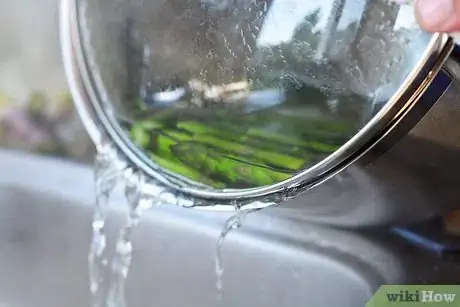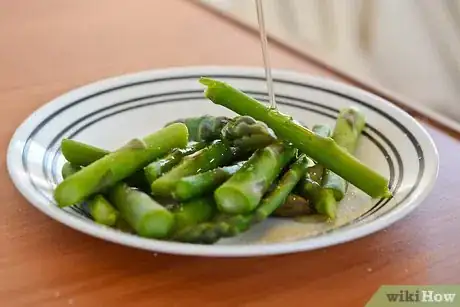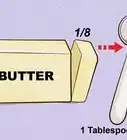This article was co-authored by Sasha Reyes. Chef Sasha Reyes is the Executive Chef and Owner of Artisan Personal Chefs. With over 20 years of food industry experience, she specializes in private dinner parties, custom sports nutrition plans for professional athletes, and cooking lessons. Chef Reyes graduated from Arizona Culinary Institute in 2011 with a degree in Culinary Arts, Baking, and Restaurant Management.
This article has been viewed 531,081 times.
The goal of cooking asparagus it to get it to a tender-crisp state, at which it is soft enough to chew but not yet soggy. To cook asparagus on the stove you can steam it, stir-fry it, or boil it. Whatever method you choose, it'll be sure to be delicious.
Ingredients
Makes 4 servings.
- 1 lb (450 g) fresh asparagus
- 1 Tbsp (15 ml) salt
- 2 Tbsp (30 ml) olive oil
- Water
Steps
Preparation
-
1Clean the asparagus. Rinse the asparagus under cool to lukewarm running water. Gently scrub the spears with your fingers to remove any excess dirt.
- Alternatively, place the asparagus in a colander and rinse the entire bunch at once. Gently shake the colander as you work to stir the spears and loosen any dirt.
-
2Break off the bottoms. Remove the woody, white bottom portion of each spear by snapping or cutting it.
- To break the end off by hand, firmly hold the asparagus spear in one hand, approximately 1 inch (2.5 cm) above the end of the white section. Grasp onto the white end with your other hand and yank it in a downward movement.
- To cut the end off, use a sharp serrate knife and saw at the spear just above the end of the white portion.
Advertisement -
3Cut the asparagus into pieces. Use a serrated knife to cut the asparagus spears into 2-inch (5-cm) sections, slicing each spear at a slight angle.[1]
Steaming
-
1Boil water inside a large pot. Fill a large pot with roughly 2 inches (5 cm) of water. Set it to boiling on the stovetop over medium-high heat.
- Do not use too much water. You need to use enough water to create steam, but you do not want the water to touch the asparagus or the bottom of the colander.
-
2Place the asparagus in a colander. Make sure to use a colander that can rest on the brim of the pot.
- A colander that dips down into the pot is ideal, but make sure that it does not touch the bottom of the pot or the water inside.
- A small wire basket, like the basket of a deep fryer, can also be used in place of the colander as long as the basket is made of food-grade metal.
- Do not use another pot. The container you rest the asparagus in must have holes in the bottom to allow steam to rise through.
-
3Rest the colander inside the pot. Cover it with the lid of the pot.
- Use aluminum foil if you do not have a lid or if the lid will not fit securely over the colander. Pinch the foil around the colander to create a seal. Otherwise, steam may escape through the cover.
-
4Cook until done. This will typically take anywhere from 4 to 5 minutes.
- Do not remove the cover as the asparagus cooks. The steam needs to remain trapped inside.
- Keep an eye on the asparagus. Well-cooked asparagus has a bright green color and crisp texture, while overcooked asparagus is dark green and mushy.
-
5Remove the asparagus and serve. Lift the lid off the pot and colander, stepping back slightly to prevent yourself from getting burned by the steam. Remove the colander and dump the asparagus out onto a serving dish.
- Use oven mitts when lifting the colander out to prevent burns.
- Use tongs to remove the aluminum foil if you used foil instead of a lid.
- Season with oil and salt, if desired. Sprinkle the salt over the asparagus in the serving dish and toss with heat-resistant serving spoons to coat.
Stir-Frying
-
1Heat the olive oil in a large skillet. Add the oil to the skillet before placing it on the stove. Heat the oil over medium-high heat for one to two minutes.
- You can also use butter or another type of vegetable oil in place of the olive oil.
- Use a wok, if you have one available. A frying pan with low sides is better than one with tall sides.
-
2Add the asparagus and cook. Dump the asparagus into the pan, adding the pieces slowly to prevent the oil from splashing on you. Cook, stirring constantly, for roughly 3 to 5 minutes.[2]
- Use a heat-resistant flat spatula to stir the pieces of asparagus.
- It is important to stir the asparagus to prevent the pieces from burning and sticking to the bottom of the pan.
- The asparagus should be tender-crisp when done. Stick a fork into the largest, thickest piece. If it goes through, the asparagus is ready. Do not allow the pieces to become soggy, however.
-
3Season with salt during the final minute. Sprinkle the pieces with salt and continue stirring to distribute the seasoning evenly.
-
4Remove from heat and serve. Turn the heat off and transfer the asparagus to a serving dish.
- Use a slotted spatula or slotted serving spoon to drain away excess oil as you transfer the asparagus.
- Alternatively, drain the oil by pouring the contents of the pan into a colander. If you do not have a colander, hold the lid of the pan over the pan itself, leaving a small gap on one side. Pour the oil through that gap and into a sink.
Boiling
-
1Boil water inside a medium saucepan. Fill the saucepan halfway with water and boil it over medium-high heat.
- Allow the water to reach a rolling boil. Large bubbles should appear to "roll" along the surface of the water.
- Do not overfill the saucepan. Filling the pan too high can cause the water to boil out and splash on the stove or on your skin.
- Do not fill the saucepan will too little water. You need enough water to completely cover the asparagus once you add it.
- You can also use a large saucepan, but the larger the pot, the longer it will take to boil the water and the more difficult it will be to regulate the temperature.
-
2Add salt to the water. Adding salt to the water prior to cooking the asparagus allows you to flavor the asparagus as it cooks.
- Alternatively, the salt can be added to the asparagus after it cooks, but the asparagus itself will have less flavor.
-
3Add the asparagus and simmer. Reduce the heat to medium or medium-low until the water bubbles, but no longer boils rapidly. Cook for 2 minutes.
- Pour the asparagus pieces into the water slowly and gently to prevent boiling water from splashing onto you.
- Start the time as soon as all of the asparagus is added. Do not wait for the temperature of the water to drop before timing it.
-
4Drain the water. Pour the contents of the saucepan through a colander to drain the asparagus.
-
5Toss the asparagus with oil before serving. Transfer the asparagus to a serving dish and add the olive oil. Toss it with two large serving spoons to coat.
- Butter or other types of vegetable oil may also be used.
- If salting the asparagus after it cooks, add the salt as you add the oil.
Community Q&A
-
QuestionAt what temperature should I cook asparagus in the oven?
 Community AnswerI would cook your asparagus in the oven for 15-20 minutes at 425 degrees F.
Community AnswerI would cook your asparagus in the oven for 15-20 minutes at 425 degrees F. -
QuestionHow do I store uncooked asparagus?
 Community AnswerGenerally asparagus will last a good four days after you buy a bunch! You can just keep it in the fridge, but I use another method: when you get home, rinse them well in cold water, fill a glass with the same cold water, and nestle the asparagus right in there with the tops protruding out of the glass. Make sure you change the water daily so that they remain hard & strong until you decide to cook them.
Community AnswerGenerally asparagus will last a good four days after you buy a bunch! You can just keep it in the fridge, but I use another method: when you get home, rinse them well in cold water, fill a glass with the same cold water, and nestle the asparagus right in there with the tops protruding out of the glass. Make sure you change the water daily so that they remain hard & strong until you decide to cook them. -
QuestionCan asparagus be frozen?
 Community AnswerYes, you may freeze asparagus.
Community AnswerYes, you may freeze asparagus.
Things You'll Need
- Serrated knife
- Large stockpot
- Colander
- Aluminum foil
- Oven mitts
- Large serving spoons
- Large skillet or wok
- Heat-resistant flat spatula
- Slotted spoon or spatula
- Medium saucepan
References
About This Article
To cook asparagus on the stove, start by rinsing it with cool water to remove any excess dirt. Snap or chop off the woody ends. Next, slice the spears into 2-inch sections, cutting at a slight angle. If you want to stir-fry the asparagus, heat olive oil in a large skillet or wok. Add the asparagus to the pan, and cook it for 3-5 minutes until the pieces are tender-crisp but not soggy. Sprinkle the asparagus with salt and enjoy!
